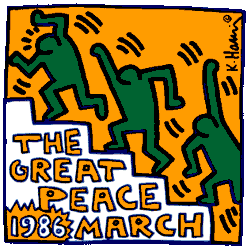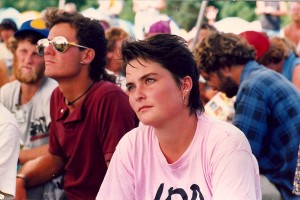I met Bonny King-Taylor in February, when I wrote about her pet coaching business, The Doggy Lama. During our conversation, she made an off-hand comment about how walking across the U.S. was part of the literal and figurative path that lead her to become a personal coach and counselor. The comment caught my interest, but was filed away in the back of my mind. Over the next four months, though, it kept coming back: who walks across the country? And, more importantly, why? I simply had to go back to her and ask.
Let me start this story by saying that talking to King-Taylor is like talking to someone at a party you can’t seem to tear yourself away from — she says so many surprising and insightful things. While satisfying my curiosity on this topic, I had to focus so as not to get thrown off track by the aside about her days as a penguin wrangler or a professional balloon decorator (think Superbowl or press events, not dog-shaped hats). See what I mean? Don’t you want to hear all about that now? You’ll have to ask her yourself when you see her.
Back to the walk, which means back to 1983. Back to Ronald Reagan and the nuclear arms race. Back to a mid-20’s young, married woman living in California, pressing herself “into a mold in which I didn’t belong.” Finding herself deeply affected by the arms race, King-Taylor heard a quote from Carl Sagan that resonated with her: “The nuclear arms race is like two sworn enemies standing waist deep in gasoline, one with three matches, the other with five.” It was a seemingly small chain of events, though, that prompted her to action. Then she saw the television movie The Day After. The next day, there was an ad on MTV for the Great Peace March for Global Nuclear Disarmament, which planted a seed. Not to be ignored, the following day her Rolling Stone magazine fell open to an article about the march. Message received: King-Taylor decided to get involved.
For a year, she participated in the Great Peace March as a volunteer, interviewing prospective marchers. King-Taylor eventually decided she would join the march herself and started training with a local group. “Ignorance was bliss,” she says about the physical and emotional challenges they would soon face.
On March 1, 1986, approximately 1,200 people gathered at Los Angeles City Hall to begin the nine month march that would bring attention to their cause. With tents and personal articles that would fit into one regular and one long milk crate, this mobile city set out with its marchers on foot and infrastructure on wheels. It was only three weeks later that the organizing umbrella, PRO-Peace, went bankrupt and ended up disbanding while marchers waited, stranded in the elements. Hundreds left and King-Taylor took time to reflect on their circumstances. Knowing that continuing without the same level of support would be a huge risk, she went back to the camp and asked what she could do.
It took three weeks to reorganize, but the marchers got some money from Paul Newman and food from the City of Claremont. Most of their equipment had been repossessed, but they still had their tents and personal belongings and the kitchen truck. King-Taylor became routes and sites coordinator, managing the logistics for planning the route, choosing sites where the group would stay overnight and getting all the necessary permits. The march was 3,742 miles, but King-Taylor guesses she, “walked, drove, cajoled and begged at least 40,000 miles back and forth negotiating with everyone.” The only technology she had were, “maps, goodwill and chutzpah. I learned how strength of will and commitment could open doors.”
At the time of the march, King-Taylor was 26. She’d been a police dispatcher, which gained her a reputation for being able to talk with authority figures. She tells many stories about the kindness of people they met along the way – and not just from supporters. She also found herself negotiating with people who tried to intimidate her, and was called a communist on occasion too. “Day after day I found myself speaking to people who didn’t want to see me,” she recalls. She pressed on, finding places to camp for a group that had grown back to about 1,500 people with three levels of government, schools, a postal system, bookmobile and a daily newspaper.
King-Taylor says before the march, she had lived a very rules-based life, but “the Great Peace March slowly ripped that away from me.” Instead, she focused on what had to be accomplished each day and drew energy from her fellow marchers. “I’d never known what family was all about until I became part of the march community,” she recalls. That family arrived at the Lincoln Memorial on November 15, 1986, just as planned. They formed such a strong bond that there are still yearly reunions.
A couple of themes have coalesced for King-Taylor since the march. One is choice: “The march taught me the power of choice. Not that choices are always pleasant — there can be lots of tears and struggle.” The other is strength. She had to make some very difficult personal decisions before and after the march. Once she was stripped of her rules and conventions, she found she was, “bulletproof in a different way than I thought.” These experiences are part of what help her make a unique connection with her clients. “I have a deep realization of myself, my choices, and that helps me to sit with people in a way that others can’t.”



This city is filled with so many amazing and interesting people. Thank you for sharing.